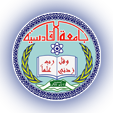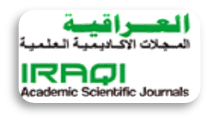Document Type
Original Study
Abstract
The ligand was prepared with a new series of chelating complexes with the following metal ions chromium (II), cobalt (II), nickel (II), Copper (II), Silver (I), Gold (III) and in different molar ratios. The results showed that the molar ratio (metal - ligand) is (1: 2) for all the complexes under study, except for the silver complex with its molar ratio (1: 1). The new metal complexes of the elements were diagnosed using available methods such as microanalysis and calculation of the ratio of metal ions in their complexes using the technique of flame atomic absorption and ultraviolet-visible and infrared spectra, in addition to the electrical conductivity of solutions of complexes as well as the magnetic sensitivity of complexes in the solid state. Based on the results obtained, the octahedral forms of all canine complexes with d
2
sp
3
hybridization were proposed) except for the gold complex, which has the shape of a planar square with dsp
2
hybridization, and the Silver Complex in a tetrahedral form with sp
3
hybridization. the research also included the study of the Bioeffect of ligand and its metal complexes in the growth of two types of bacteria using solvent DMSO and diffusion technique on Acar medium as Gram positive bacteria) and bacteria (Escherichia coli) are representatives of Gram-negative bacteria (gram negative bacteria, causing many diseases The rumor. This ligand and its metal complexes have been found to have varying bioavailability as antibiotics in inhibiting bacterial growth.
Keywords
heterogeneous azo, metal complexes, TGA and mass spectrum
Recommended Citation
Tareer, Samer Alwan; dakhil, Haitham Kadhim; and Bedaiwi, Zainab Mohsen
(2024)
"Preparation of the ligand (E)-2-amino-5-((4,5-dimethylthiazol-2-yl)diazenyl)-3,4-dimethylbenzoic acid and some Complexes,"
Al-Qadisiyah Journal of Pure Science: Vol. 29
:
No.
2
, Article 21.
Available at:
https://doi.org/10.29350/2411-3514.1303
Creative Commons License

This work is licensed under a Creative Commons Attribution-NonCommercial-No Derivative Works 4.0 International License.










